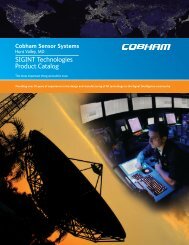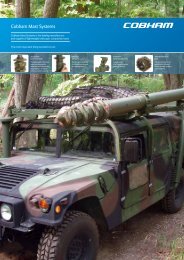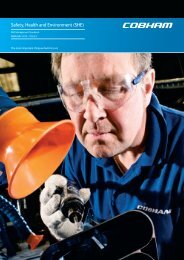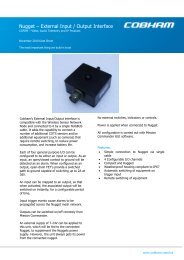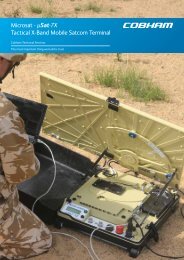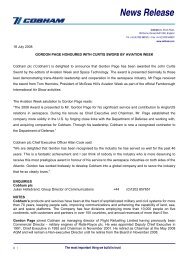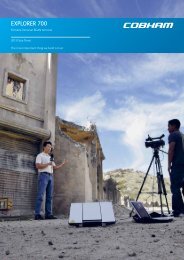installation an operation for sea tel model coastal 18 satellite tv ...
installation an operation for sea tel model coastal 18 satellite tv ...
installation an operation for sea tel model coastal 18 satellite tv ...
Create successful ePaper yourself
Turn your PDF publications into a flip-book with our unique Google optimized e-Paper software.
Coastal <strong>18</strong> Ku-B<strong>an</strong>d TVRO Basic System In<strong>for</strong>mation<br />
from you <strong>an</strong>d how close you are to the Equator (refer to the polarization in<strong>for</strong>mation in the Setup <strong>an</strong>d the<br />
Operation sections of this m<strong>an</strong>ual).<br />
3.2. Antenna Basics<br />
The following in<strong>for</strong>mation is provided to explain some of the basic functions of the <strong>an</strong>tenna:<br />
3.2.1. Azimuth<br />
The <strong>an</strong>tenna c<strong>an</strong> rotate a total of 680 degrees between two mech<strong>an</strong>ical stops. Azimuth drive, provided<br />
by the azimuth motor, is required during stabilization, <strong>sea</strong>rching, tracking <strong>an</strong>d unwrap <strong>operation</strong>s of the<br />
<strong>an</strong>tenna. When the boat turns, azimuth is driven in the opposite direction to remain pointed at the<br />
sa<strong>tel</strong>lite. The actual azimuth pointing <strong>an</strong>gle to the sa<strong>tel</strong>lite is determined by your latitude & longitude <strong>an</strong>d<br />
the longitude of the sa<strong>tel</strong>lite. It is import<strong>an</strong>t to know that the <strong>an</strong>tenna should be pointed generally toward<br />
the equator.<br />
Refer to figure 3-1. The azimuth would be <strong>18</strong>0 degrees true (relative to true north) if the sa<strong>tel</strong>lite is at the<br />
same longitude that you are on. If the sa<strong>tel</strong>lite is east, or west, of your longitude the azimuth will be less<br />
th<strong>an</strong>, or greater th<strong>an</strong> <strong>18</strong>0 degrees respectively.<br />
When checking <strong>for</strong> blockage you c<strong>an</strong> visually look over the <strong>an</strong>tenna radome toward the equator to see if<br />
<strong>an</strong>y objects are in that sighted area. If you are not able to find <strong>an</strong>y sa<strong>tel</strong>lites it may also be useful to<br />
remove the radome top to see if the dish is aimed in the correct direction (towards the equator).<br />
3.2.2. Elevation<br />
The <strong>an</strong>tenna c<strong>an</strong> rotate up <strong>an</strong>d down in elevation. Elevation drive, provided by the elevation motor, is<br />
required during stabilization, <strong>sea</strong>rching <strong>an</strong>d tracking <strong>operation</strong>s of the <strong>an</strong>tenna. The actual elevation<br />
pointing <strong>an</strong>gle to the sa<strong>tel</strong>lite is determined by your latitude & longitude <strong>an</strong>d the longitude of the sa<strong>tel</strong>lite.<br />
In general terms the elevation <strong>an</strong>gle will be low when you are at a high latitudes <strong>an</strong>d will increase as you<br />
get closer to the equator.<br />
Refer to figure 3-1. Additionally, from <strong>an</strong>y given latitude, the elevation will be highest when the sa<strong>tel</strong>lite is<br />
at the same longitude that you are on. If the sa<strong>tel</strong>lite is east, or west, of your longitude the elevation<br />
<strong>an</strong>gle will be lower.<br />
3.2.3. Antenna polarization (Linear or Circular)<br />
Your Coastal Series <strong>an</strong>tenna c<strong>an</strong> have a linear, or a circular, LNB installed.<br />
When you are in <strong>an</strong> area where you w<strong>an</strong>t to receive linear polarized sa<strong>tel</strong>lite signals, you will have to<br />
install a linear LNB. When you have a Linear LNB installed, polarization adjustment is required when<br />
initially setting up the system, when ch<strong>an</strong>ging from one sa<strong>tel</strong>lite to <strong>an</strong>other <strong>an</strong>d to compensate <strong>for</strong> the roll<br />
<strong>an</strong>d pitch motion of the boat when underway.<br />
Polarization is automatically adjusted by the system when ch<strong>an</strong>ging from one sa<strong>tel</strong>lite to <strong>an</strong>other,<br />
periodically as the boat ch<strong>an</strong>ges geographic locations by a signific<strong>an</strong>t amount of latitude <strong>an</strong>d longitude<br />
<strong>an</strong>d to compensate <strong>for</strong> roll <strong>an</strong>d pitch motions of the boat when underway.<br />
The Polarization display will read 000 when the LNB is rotated full CW, 090 when the LNB rotation is<br />
centered <strong>an</strong>d <strong>18</strong>0 when the LNB is rotated full CCW (as viewed from the back of the dish).<br />
When you are in <strong>an</strong> area where you w<strong>an</strong>t to receive circular polarized sa<strong>tel</strong>lite signals, you will have to<br />
install a circular LNB. When you have a circular LNB installed polarization adjustment is NOT required,<br />
however, the auto-polarization function will operate as described above.<br />
3-3




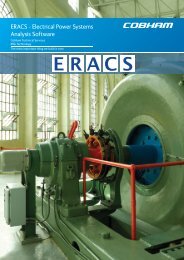
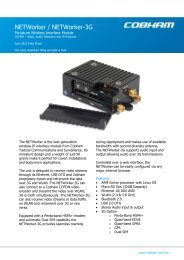
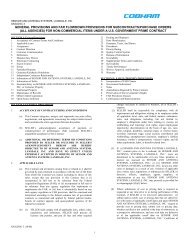
![NC1147 (pdf 1.47 mb) Nitrogen Concentrator [OBIGGS] - Cobham plc](https://img.yumpu.com/51124104/1/190x245/nc1147-pdf-147-mb-nitrogen-concentrator-obiggs-cobham-plc.jpg?quality=85)
